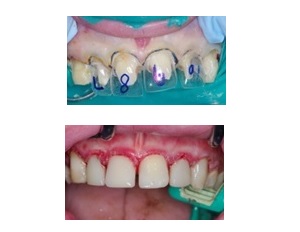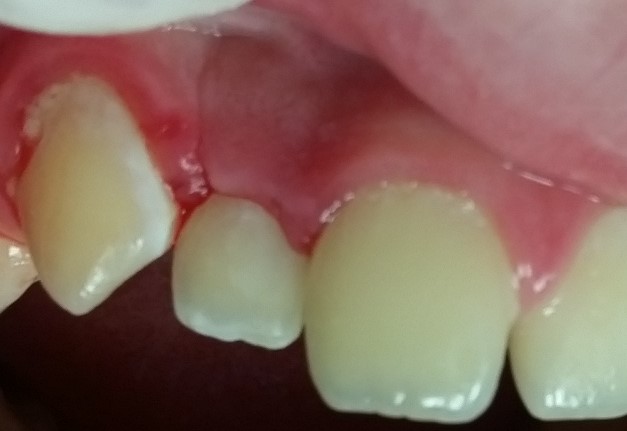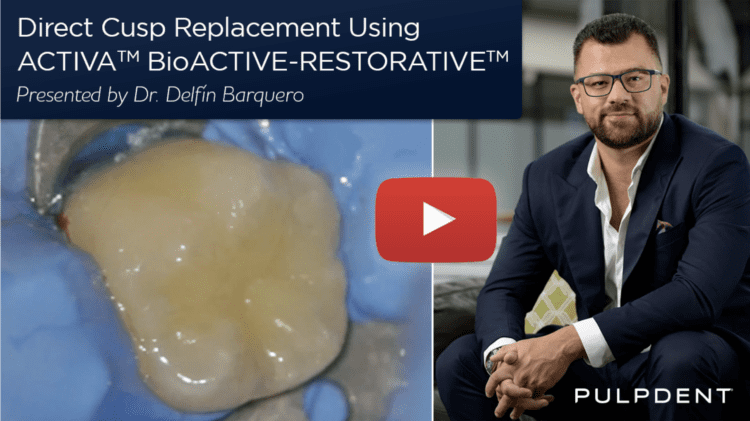ACTIVA KIDS y ACTIVA Presto Restauración
Por Carla Cohn DMD
Los niños deben aprender a practicar la higiene bucal desde una edad temprana, y los dentistas pediátricos están especialmente formados para tratar a los pequeños y educar a sus padres en el cuidado de la salud bucal. La caries puede desarrollarse cuando empiezan a salir los dientes primarios, y mantener una dentición primaria sana es importante para el crecimiento y desarrollo de la arcada y el bienestar emocional del niño.
Esta niña de 5 años no se benefició de una atención oral temprana y tenía múltiples lesiones de caries. Teniendo en cuenta la corta edad, el alto riesgo de caries y la incertidumbre sobre el cumplimiento de las citas de seguimiento, quise restaurar todos los dientes en una sola visita y sellar los dientes no cavitados y libres de caries. En este estudio de caso se muestra un cuadrante. La lesión de caries del diente J (65) está cavitada y se preparará, restaurará y sellará. El diente I (64) no está cariado y se sellará (Figura 1).
Elegí Restaurador Bioactivo ACTIVA KIDS y ACTIVA Presto porque he observado excelentes resultados clínicos a lo largo del tiempo con estos materiales bioactivos. La liberación continua de calcio, fosfato y flúor de estos materiales es beneficiosa en la lucha contra la caries a largo plazo. La facilidad de uso y la capacidad de trabajar rápidamente eran importantes en este caso, y todas las restauraciones se completaron con anestesia general en una sola cita. Había facetas de desgaste en las superficies oclusales de los molares, por lo que es importante utilizar un material que tenga cierta flexibilidad y resistencia a la fractura. La innovadora composición de ACTIVA KIDS incluye un componente de resina cauchutada que absorbe las fuerzas y sería un material de obturación ideal para este caso. ACTIVA Presto comparte propiedades similares y era conveniente utilizarlo como sellador de la superficie oclusal.

El diente J (65) se preparó con una fresa de diamante cónica gruesa de alta velocidad que permitía cierta retención mecánica menor al incorporar una socavadura mínima en la preparación. La superficie oclusal del diente I (64) también se talló ligeramente con una fresa de diamante (Figura 2). Las preparaciones se grabaron selectivamente con ácido fosfórico, se aclararon y se secaron ligeramente (Figura 3). Se aplicó agente adhesivo a toda la superficie oclusal de ambos dientes, se diluyó con aire y se fotopolimerizó (figura 4).
El diente J (65) se rellenó en bloque con ACTIVA KIDS. Para esta técnica de inyección rápida, coloca la punta dispensadora en el suelo de la preparación, y extruye el material sin retirar la punta hasta que la preparación esté completamente rellena (Figura 5). Me gusta hacer algunas manipulaciones menores del material de relleno con instrumentos manuales para crear anatomía y asegurarme de que el material queda a ras de la superficie de la preparación y no queda aire atrapado en el material. ACTIVA KIDS es de polimerización dual, ideal para rellenos masivos, y polimeriza con todas las luces. A continuación se colocó una fina capa superior de ACTIVA Presto como sellador en toda la superficie oclusal de los dientes I y J (64 y 65) (Figura 6). La figura 7 muestra la situación clínica final.

La Dra. Carla Cohn, DMD, se graduó en la Facultad de Odontología en la Universidad de Manitoba en 1991. Amplió su formación realizando prácticas de posgrado en Odontología Infantil en el Hospital Infantil del Centro de Ciencias de la Salud. La Dra. Cohn asiste regularmente a programas de formación continua para mantenerse al día en los últimos avances de la odontología moderna. Mientras ejerce en Kids Dental, Carla sigue apoyando la «odontología hospitalaria», es decir, el tratamiento de niños con anestesia general en quirófano.




